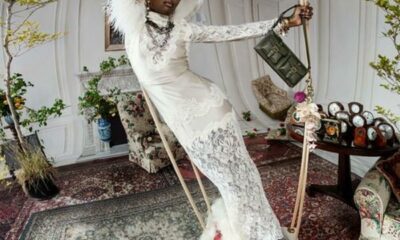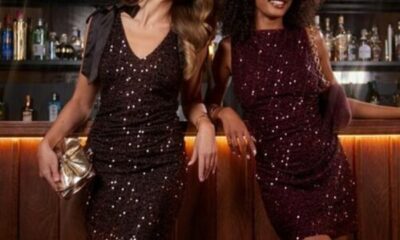Fashion
Paris is torn between Elie Saab’s working girl and the whimsical creations of Japanese designers
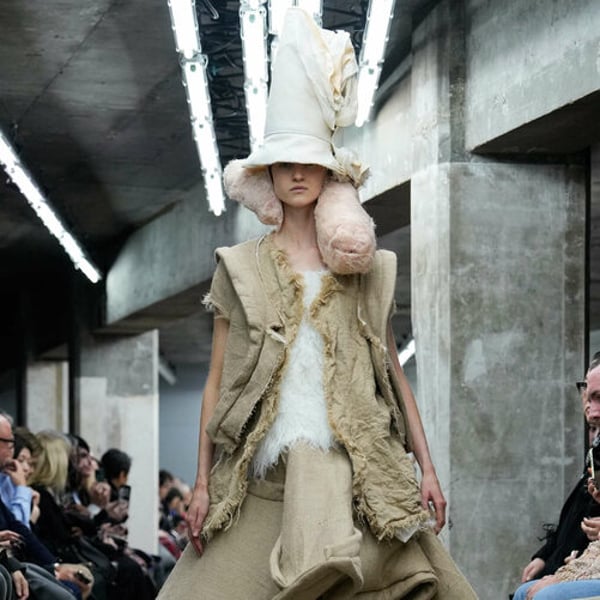
Published
October 5, 2025
Japan’s leading fashion houses once again made a major splash at Paris Fashion Week on Saturday, as evidenced on the sixth day of the women’s ready-to-wear shows for spring-summer 2026 by three of the country’s most emblematic labels: Junya Watanabe, Noir by designer Kei Ninomiya, and Comme des Garçons. On the same day, Elie Saab sent his army of power women down the catwalk.
As so often, it was Rei Kawakubo‘s show for Comme des Garçons that moved us most and left the deepest impression. In today’s chaotic world, where catastrophes and human tragedies follow one after another, the designer seemed intent on returning to origins, reconnecting with the values of the Earth. Folk songs and traditional tunes accompanied the show.
A procession of amorphous, swollen silhouettes advanced, draped in great swathes of burlap, hemp or linen, hastily knotted, or in old lace sheets, curtains and bedspreads. Some jackets appeared to be cut directly from the large beige canvas sacks used to store potatoes and other produce from the land. A waistcoat and goat-hair coats completed this rustic look.
These sculptural garments, generated by the play of layering, volume and padding techniques, lent a sense of solemnity to the whole. Topped with battered top hats and cotton-wool hair in pastel shades, the models evoked rag dolls or cloth puppets—old crones or witches—burned in the countryside in January in antiquity to lay the past year to rest and celebrate a richer, more auspicious new season.
This season, Junya Watanabe pushed the boundaries further in his experimental exploration of clothing, delivering a breathtaking collection in which constructions were constantly reinvented, with unexpected intrusions along the way. The Japanese designer folded, with complete ease, the ordinary elements of the textile universe and everyday life into his creations—objects and accessories that usually pass unnoticed.
The result was at once surreal and playful. Old white lace parasols unfurled like a corolla at the hem of a summer dress, while a flock of straw hats created a ruffled volume at the collar and across the shoulders of a long evening gown in nude-coloured guipure lace.
Bright red pumps adorned the shoulders of a black sheath. A cascade of metallic cutlery formed the sleeves of a crinkled silver nylon T-shirt. Rendered in gold, knives and forks compose intriguing sculptures on a shoulder or a flank. The emblematic coat hanger completed this kind of “prévert inventory”: trench coats, shirt dresses and polka-dot dresses were threaded onto it two or three at a time, then secured to either side of the body.
At Noir, Kei Ninomiya continued to explore three-dimensional structures through a mathematical approach. By infinitely multiplying elements as modules—flowers, stars or metal cones, for example—he created fairytale, sculptural ensembles. The show opened with a series of white tulle petticoats paired with sparkling, silver, carapace-like tunics.
The models’ faces were masked or hidden by bulky headdresses, reminiscent of aggregates of quartz crystals or other organic forms. In black and white, they also appeared in unexpected fluorescent hues (pink, orange, and yellow). Paradoxically, behind this whimsical appearance lies a rather classic, even retro wardrobe, composed of prim white blouses, black balloon or pleated skirts, and suits with gathered ruffles. Not forgetting platform moccasins set on a platform and fitted with a small stiletto heel.
These outfits were enhanced by harnesses or cage tunics slipped over the garments, to which all manner of spectacular structures were attached: a giant star covered in precious stones, a basket-dress-shaped grid formed by a Meccano-like chain, clouds of tulle, glittering garlands and other fabric petals.
A change of register at Elie Saab. The mood evoked the electric air of the great metropolises. In the darkness, the sound of heels echoed on the pavement. Suddenly, silhouettes emerged in a fog bathed in a ruddy glow. The first model cut across the catwalk. The tone is set—a little like “Bright Lights, Big City”.
The look was that of the working girl: a chic, tailored suit; a pencil skirt with a back slit; a silk blouse with a plunging neckline; or little polka-dot tops. She’s as at ease in pleat-front trousers as in a strapless python-skin dress, and has never looked more elegant than simply wearing a flowing camel trench that slips over her skin, or a jacket and T-shirt with those sensual, floaty silk trousers with a denim effect.
Her favourite game? Mix & match. She happily pairs Prince of Wales check with polka dots, a leather skirt with a metallic-fringed tank top, a worn leather jacket with an openwork sequinned skirt. For evening, the Elie Saab woman pulls out all the stops with glittering draped maxi dresses or shorter dresses with long trains.
This article is an automatic translation.
Click here to read the original article.
Copyright © 2025 FashionNetwork.com All rights reserved.
Fashion
India’s Tibarumal Jewels launches lab-grown diamond jewellery brand Elevé Diamonds

Published
November 19, 2025
South Indian fine jewellery brand Tibarumal Jewels has expanded its presence in the lab-grown diamond market with the launch of its new label Elevé Diamonds. The move marks Tibarumal Jewels’ shift from a heritage jewellery brand to expanding into the contemporary, global market.
“Elevé began as a way to serve the community that has always trusted Tibarumal Jewels,” said Elevé Diamonds’ co-founder and managing director Trishank Gupta in a press release. “Over time, it has grown into its own brand, a tribute to the century-old name, tradition, and legacy of Tibarumal’s quality. Having grown up surrounded by jewellery and wanting to create something fresh and meaningful, Elevé became the perfect blend of heritage and modern style, a brand that connects with today’s generation while honouring the past. In simple words, with Elevé, we’re not just continuing the family tradition; we’re elevating it.”
Based in Hyderabad, Elevé Diamonds has debuted with flagship stores in Kokapet, Kompally, and Warangal, and has plans to open at more locations. Next year, the brand will expand internationally with the aim of building a strong global presence.
“Luxury today isn’t about indulgence, it’s about intention,” said the brand’s CEO Prajay Maganlal. “I see it every day in our customers; they want beauty that feels good, not just looks good. At Elevé, we’ve reimagined the experience of the family jeweller, where trust and warmth meet exquisite design and modern craftsmanship. Every collection is thoughtfully created to make our jewellery feel closer, more personal, and effortlessly accessible, an experience that celebrates both brilliance and conscience.”
Elevé Diamonds uses advanced CVD (Chemical Vapor Deposition) technology to create its lab-grown diamonds, which are IGI-certified. The brand targets the accessible luxury segment of the market and counts collections including ‘Nizam’ and ‘Victorian Polki.’
Copyright © 2025 FashionNetwork.com All rights reserved.
Fashion
China retail sales up 4.3%, industry maintains strong 2025 momentum
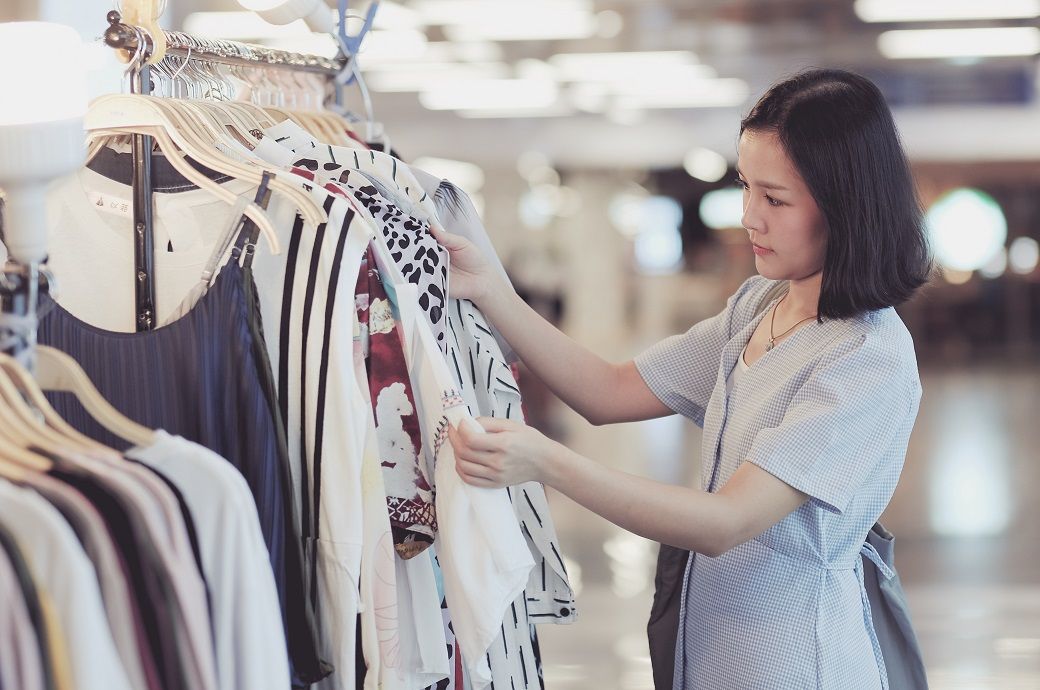
China’s retail and industrial indicators for the first 10 months of 2025 signalled steady economic recovery, with consumption and high-tech manufacturing showing notable strength, according to data released by the National Bureau of Statistics (NBS).
China’s economy showed steady recovery in the first 10 months of 2025, with retail sales up 4.3 per cent to $5.82 trillion and online sales rising 9.6 per cent.
October retail grew 2.9 per cent.
Industrial value-added rose 6.1 per cent in Jan–Oct and 4.9 per cent in October.
Profits reached ¥5.37 trillion.
PMI was 49, while expectations stayed upbeat at 52.8.
Retail sales of consumer goods rose 4.3 per cent year on year (YoY) to ¥41.2169 trillion (~$5.82 trillion). Online retail sales reached ¥12,791.6 billion, up 9.6 per cent, with physical goods contributing ¥10,398.4 billion, accounting for 25.2 per cent of total retail sales.
In October alone, retail sales grew 2.9 per cent YoY to ¥4,629.1 billion. Urban retail sales rose 2.7 per cent, while rural consumption expanded 4.1 per cent, the National Bureau of Statistics (NBS) said in a release.
Industrial activity also gained traction. The total value added of industrial enterprises above the designated size increased 4.9 per cent YoY in October and 0.17 per cent month on month (MoM).
For January–October, industrial value added grew 6.1 per cent YoY. Industrial enterprises earned profits of ¥5,373.2 billion in the first nine months, up 3.2 per cent YoY. October’s Manufacturing Purchasing Managers’ Index stood at 49 per cent, while the Production and Operation Expectation Index reached 52.8 per cent, indicating continued optimism among manufacturers despite short-term pressures.
Fibre2Fashion News Desk (HU)
Fashion
Mulberry turnaround on track, H1 sales still dip but losses narrow sharply

Published
November 19, 2025
Mulberry delivered its half-year results on Wednesday and the luxury leathergoods business said the 26 weeks to the end of September showed “strong momentum” with the company executing its strategy “at pace”.
Not that this means its numbers were all positive. In fact its revenue fell 4% to £53.9 million but with a strong reaction from Wholesale (+36%) “aligned to the strategic emphasis”.
Overall like-for-like Retail & Digital revenue declined 2%, but in Retail Stores, both full-price and off-price, like-for-like revenue increased 4% in the key markets (UK, Europe and US), with positive momentum building since Q2.
Asia Pacific revenue was down 17% versus last year, driven by like-for-like declines in stores (-14%) and store closures (-3%) as the strategy of structure simplification continued.
The gross margin increased to 69% from 67% by it maintaining a full price, non-discounted offering in Retail and Digital.
Meanwhile, gross profit was only flat at £37.3 million. That said, the operating loss improved by 63% going from £13.1 million a year ago to a much narrower loss of £4.9 million this time. And the loss before tax also narrowed by 56% hitting £6.9 million in the latest period. That includes adjusting items of a net credit of £1 million for the closure of five retail stores and UK head office restructuring costs.
That was all on a reported basis. The group’s underlying loss for the period of £7.4 million was smaller than the £15.2 million of a year earlier and “was delivered through stable gross profit, enhanced by the results of the review of the operating cost base in implemented in FY25 and continuing cost control”.
Trading was in line with the board’s expectations and the focus during the period was on executing the ‘Back to The Mulberry Spirit’ strategy previously outlined, and on “operational discipline to improve margins and cost control”.
New products
The half saw the first product launch under the new creative team with the Roxanne family and continued evolution of key families including the Bayswater 9 to 5. It also saw strong engagement with new marketing campaigns to connect with new and existing customers, including Cynthia Erivo as a brand ambassador in September 2025.
The optimisation of the store network including closure of six stores in Asia, and new wholesale agreements in the UK with John Lewis, Liberty and Harvey Nichols.
The company also said the positive trading momentum is continuing in H2, despite ongoing external headwinds and inflationary pressures for the sector.
The second half also sees the launch of new products — the Hackney, the Lennox and the Boston — and the company is “well set for the key festive trading period”.
CEO Andrea Baldo said that “this has been an encouraging first half as we continue to deliver our ‘Back to the Mulberry Spirit’ strategy. We’re still early in the turnaround, but the foundations we’ve put in place are working, and we’re starting to see that reflected in performance.
“We’re strengthening our margin and improved our cash position through a greater focus on full-price sales and disciplined cost management, while our refreshed product offer and creative direction are reconnecting the brand with customers. The strong response to new icons the Roxanne and Hackney shows that Mulberry’s distinctive spirit continues to resonate”.
Copyright © 2025 FashionNetwork.com All rights reserved.
-

 Tech1 week ago
Tech1 week agoFrom waste to asset: Turning ethanol production CO₂ into jet fuel
-

 Tech4 days ago
Tech4 days agoNew carbon capture method uses water and pressure to remove CO₂ from emissions at half current costs
-

 Politics5 days ago
Politics5 days agoBritish-Pakistani honoured for transforming UK halal meat industry
-

 Sports4 days ago
Sports4 days agoTexas A&M officer scolds South Carolina wide receiver after touchdown; department speaks out
-

 Business4 days ago
Business4 days agoThese 9 Common Money Mistakes Are Eating Your Income
-

 Business5 days ago
Business5 days agoWhat’s behind Rachel Reeves’s hokey cokey on income tax rises?
-

 Tech5 days ago
Tech5 days ago$25 Off Exclusive Blue Apron Coupon for November 2025
-
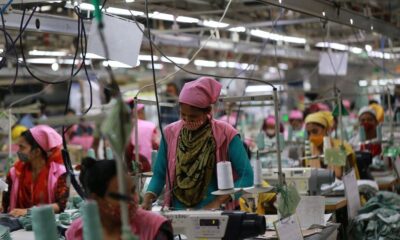
 Fashion1 week ago
Fashion1 week agoBangladesh garment makers eye $5 bn more in exports post policy tweak







